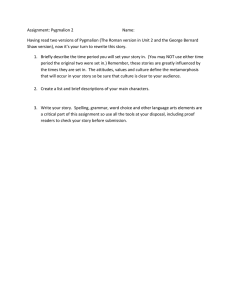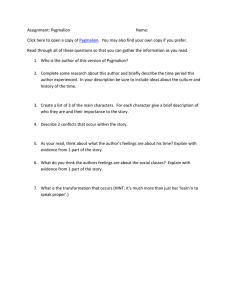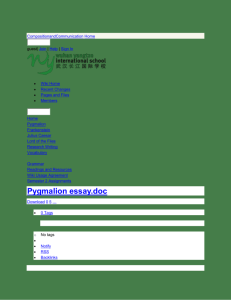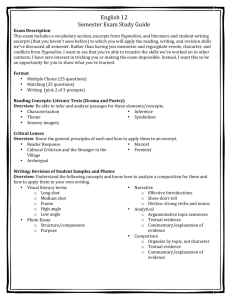Teacher Pygmalion Effect on EFL Learners' Oral Performance
advertisement
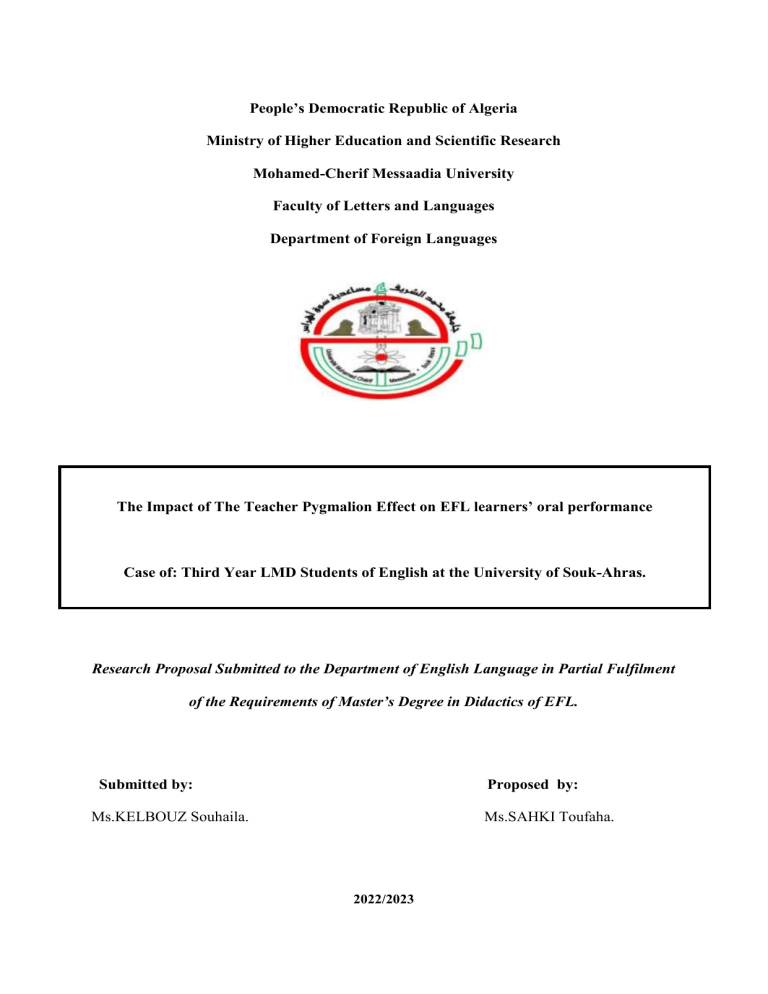
People’s Democratic Republic of Algeria Ministry of Higher Education and Scientific Research Mohamed-Cherif Messaadia University Faculty of Letters and Languages Department of Foreign Languages The Impact of The Teacher Pygmalion Effect on EFL learners’ oral performance Case of: Third Year LMD Students of English at the University of Souk-Ahras. Research Proposal Submitted to the Department of English Language in Partial Fulfilment of the Requirements of Master’s Degree in Didactics of EFL. Submitted by: Proposed by: Ms.KELBOUZ Souhaila. Ms.SAHKI Toufaha. 2022/2023 Table of Content 1. Literature Review ……………………………………...………………….........……….. 2. Statement of the Problem………………………………………………...........……….. 3. Research Questions…………………………………………….………..……………… 4. Hypotheses……………………………………………………......................................... 5. Research Methodology………………………………..………………….…………..… 6. The Structure of Dissertation………………………………………………........… 7. Key Words………………………………………………………………………….……. 8.References……………………………………………………….……………………..... 3. Literature Review : Babad , (1985) stated that the Pygmalion effect is a kind of self-fulfilling prophecy positive in its nature and outlook that shows how teachers' expectations can influence students' performance. The higher the expectations from the teacher, the more satisfying are the results of the students and their overall performance too. “When we expect certain behaviours of others, we are likely to act in ways that make the expected behavior more likely to occur." (Sarrazin, 2003).Also, Rosenthal & Jacobson , (1968) had said that studies such as Pygmalion in the Classroom have displaced an abondance amount of pressure on teachers and away from students’ individual characteristics and intellect. Not only has this negatively affected the teachers but also the results suggest that shortcomings of students’ achievements could in part be caused by their teachers’ low expectations. (Murphy et al., 1999; Rosenthal & Jacobson, 1968; Marburger, 1963). Authors have argued that experiments designed to correlate low test scores with lack of teacher expectation tend to disservice teachers and schools, encouraging federal policy makers to question teacher training and management of schools (Murphy et al., 1999).Next, Jussim, (1989) wrote that the teacher expectancies have the detrimental effect of biased evaluation of students’ performance .This multi-dimensional issue arises in a two step process; first teachers form expectancies of the students early in the year on the basis of a few interactions,then with these same lens of preconceived notions about the students they assess their performance.(Brophy & Good, 1974). A large body of research clearly articulates the importance of teachers in student achievement in addition studies have also been conducted to illustrate the degree of students’ understanding of their teachers’ expectations of them affect achievement. Specifically highlighting the notion that students hold expectancies of their own about teachers as well and these perceptions can also affect student performance and level of motivation. (Jamieson, Lydon, Stewart, & Zanna, 1987). 4.Statement of the problem: .Byrne (1986:8) states that: “Oral communication is two-way process between speaker and listener and involves the productive skill of speaking and the receptive skill of understanding (or listening with understanding).” The nature of oral communication is the ability to communicate expressing themselves through words while others may express themselves in writing or through body language. Oral performance involves the negotiation of meaning between two persons; it is always related to the context in which it occurs. Communication is the main objective of learning a foreign language. One of the major responsibilities of any teacher is to enable students to perform effectively through oral language. It is important for students to learn to speak English well and for teachers to know how to teach speaking well. Teachers must address this questions:how to increase the learners’ achievement especially during the oral performance there are many factors that can affect EFL learner’s presentation such psychological one like : motivation which is defined as a driving force behind human action.It is the process that initiates ,guides, maintain goal –oriented behavoir and we have also the teacher Pygmalion effect is one of the major contributors on the success or the failure of the performance. The aim of the study is to clarify how can the teacher’s expectation influence the learner’s oral performance. 5. Research questions: This study is guided by the following questions: -Does the teacher Pygmalion effect affect EFL learner’s orl performance? .How can the teacher Pygmalion effect affect the EFL learner’s orl performance? 6.Hypotheses : To answer the questions above ;the following hypothesis are suggested : 1-the teacher Pygmalion effect can influence on the EFL learner’s oral performance by giving them a great self confidence in thier capacities. 2- the teacher Pygmalion effect can influence negatively on the EFL learner’s oral performance when there is no balance between the teacher expectation and the learner’s preparation. 7.Research methodology a) Research design This study will use exploratory sequential mixed method as an approach to combining qualitative and quantitative data collection and analysis in a sequence of phases (two-phase design). In the first phase, the researcher will collect qualitative data and then analyze the data, the results of which direct the next, quantitative phase, which will be a questionnaire and an experiment as form of quantitative data collection. b) Population and sampling In this study, the population consists of EFL third year bachelor classes at the University of Mohamed Cherif Messaadia at Souk-Ahras, in the academic year 20222023.. The students that make the sample represent 40 students. The main reasons for choosing third year bachelor EFL learners are: because oral academic comprehension is a fundamental module, so we will have enough time to conduct the questionnaire and the interview . Also, the researcher has more accesses to that specific level and the population number is more manageable, not too large and not too small, and the sample will fairly represent the entire population. c) Data collection tools Questionnaire: The questionnaire will be in two forms open-ended and closedended. Open-ended questions allow the respondents to add explanations, whereas closed-ended questions involve the respondents to select one or more choices that are provided in the questionnaire. Interview: the interview will be composed of selective questions that can highlight the teachers point of views thier previous knowledge about the topic ;the application of the Pygmalion effect . d) Data analysis and presentation a) Data analysis In this study both qualitative and quantitative methods will be used to analyze the data that will be collected from the field. The analysis process begins by examining a myriad amount of information and organizing it into codes, themes, and categories. This is followed by an identification of the connections, relationships, and patterns in the data, and pulling them together into a significant whole that describes and explains the issue at the heart of the investigation. b) Data presentation In this study the researcher will present the data by using qualitative approach which will present the data related to description form. The researcher also will present the data by quantitative approach through using graphs and tables. This method will enable the researcher to summarize the results of the investigation of the impact of the teacher pygmalion effect on EFL learners’ oral performance e) Ethical issues Ensuring that ethical standards are followed lies at the heart of any good research. In this sense, the researcher will make sure that the rights of all participants in this work will be protected. Accordingly, before issuing questionnaires, the researcher will obtain permission to carry out this investigation from the Department of Foreign Languages. Besides, participants will be informed about the purpose of the study and they will also be provided with full explanation about the content of the questionnaire and the interview and their role in this research. Very importantly, and to maintain the privacy and anonymity of participants, they will not be asked to mention their names when answering the questionnaire. f) Structure of the dissertation The current dissertation will be consisted of a general introduction, three chapters, and a general conclusion. The first chapter will provide an overview about oral performance including various definitions, types of oral performance ,and features of effective oral performance and approaches to teaching it , and finally problems and challenges that may face learners while performing orally. The second chapter will provide information about cooperative language the teacher Pygmalion effect including its definitions, its theories, principles,and ways to be applied in the classroom in relation to oral performance . The third chapter will be about field investigation and data analysis. It will introduce the population/sample chosen and why it was chosen, it will describe the data collection tools; the questionnaire and interview , and the aim behind each one. Moreover, It will provide data discussions and presentation i.e. interpretation and analysis of the findings. The data will be presented both qualitatively and quantitatively. This method will enable the researcher to summarize the results of the investigation of the impact of the teacher pygmalion effect on EFL learners’ oral performance . 2 .Key words: Pygmalion Effect, Self-fulfilling prophecy, Reflexive practice, Classroom teaching, Teacher Expectation 8.List of References: Altman, K. (2015, May 3). 7th Annual CADDAC Conference. Retrieved August 13, 2015, from http://www.peopleforeducation.ca/event/7th-annual-caddac-conference/ Babad, E. Y., Inbar, J., & Rosenthal, R. (1982). Pygmalion, Galatea, And The Golem: Investigations Of Biased And Unbiased Teachers.. Journal of Educational Psychology, 74(4), 459-474. Bandura, A. (1977). Self-efficacy: Toward a unifying theory of behavioral change. Psychological Review, 84(2), 191-215. Bandura, A. (1986). Social foundations of thought and action: A social cognitive theory. Englewood Cliffs, NJ: Prentice-Hall. Bandura, A. (1997). Self-Efficacy: The exercise of control. New York, NY: W. H. Freeman. Boer, H., Bosker, R., & Margaretha P. C. Van Der Werf. (2010). Sustainability of teacher expectation bias effects on long-term student performance. Journal of Educational Psychology, 168-179. Brophy, J. E. (1983). Research on the self-fulfilling prophecy and teacher expectations.. Journal of Educational Psychology, 75(5), 631-661. Brophy, J., & Good, T. (1974). Teacher-student relationships: Causes and consequences. New York: Holt, Rinehart and Winston Brehm, S. S., & Kassin, S. M. (1996). SOCIAL PSYCHOLOGY. Boston: Houghton Mifflin. Brylinsky, J. A., & Moore, J. C. (1984). The identification of body build stereotypes in young children. JOURNAL OF RESEARCH IN PERSONALITY, 28, 170-181. Collins, J. K., & Plahn, M. R. (1988). Recognition, accuracy, stereotypic preference, aversion, and subjective judgment of body appearance in adolescents and young adults. JOURNAL OF YOUTH AND ADOLESCENCE, 17(4), 317-334. Good, T. L. (1987). Two decades of research on teacher expectations: Findings and future directions. JOURNAL OF TEACHER EDUCATION, 38(4), 32-47. EJ 358 702 Hunsberger, B., & Cavanagh, B. (1988). Physical attractiveness and children's expectations of potential teachers. PSYCHOLOGY IN THE SCHOOLS, 25(1), 70-74. EJ 368 520 Jussim, L., & Eccles, J. (1992). Teacher expectations: II. Construction and reflection of student achievement. JOURNAL OF PERSONALITY & SOCIAL PSYCHOLOGY, 63(3), 947-961. Kenealy, P., Frude, N., & Shaw, W. (1988). Influence of children's physical attractiveness on teacher expectations. JOURNAL OF SOCIAL PSYCHOLOGY, 128(3), 373-383. EJ 376 901 www.eric.ed.gov ERIC Custom Transformations Team Page 6 of 7 ED426985 1998-12-00 Good or Bad, What Teachers Expect from Students They Generally Get! ERIC Digest. Merton, R. K. (1948). The self-fulfilling prophecy. ANTIOCH REVIEW, 8, 193-210. Oakes, A. (1996, April 22). Labeling deprives you of the most fulfilling relationships. DAILY COLLEGIAN, p. 11. PRODUCTIVITY AND THE SELF-FULFILLING PROPHECY: THE PYGMALION EFFECT. (1987). Video. Carlsbad, CA: CRM Films. Rosenthal, R., & Jacobson, L. (1968). PYGMALION IN THE CLASSROOM. New York: Holt, Rinehart & Winston. Tauber, R. (1997). SELF-FULFILLING PROPHECY: A PRACTICAL GUIDE TO ITS USE IN EDUCATION. Westport, CT: Praeger. Thomas, W. I. (1928). THE CHILD IN AMERICA. New York: Knopf. Wagar, W. W. (1963). THE CITY OF MAN, PROPHECIES OF A MODERN CIVILIZATION IN TWENTIETH-CENTURY THOUGHT. Boston: Houghton Mifflin.
